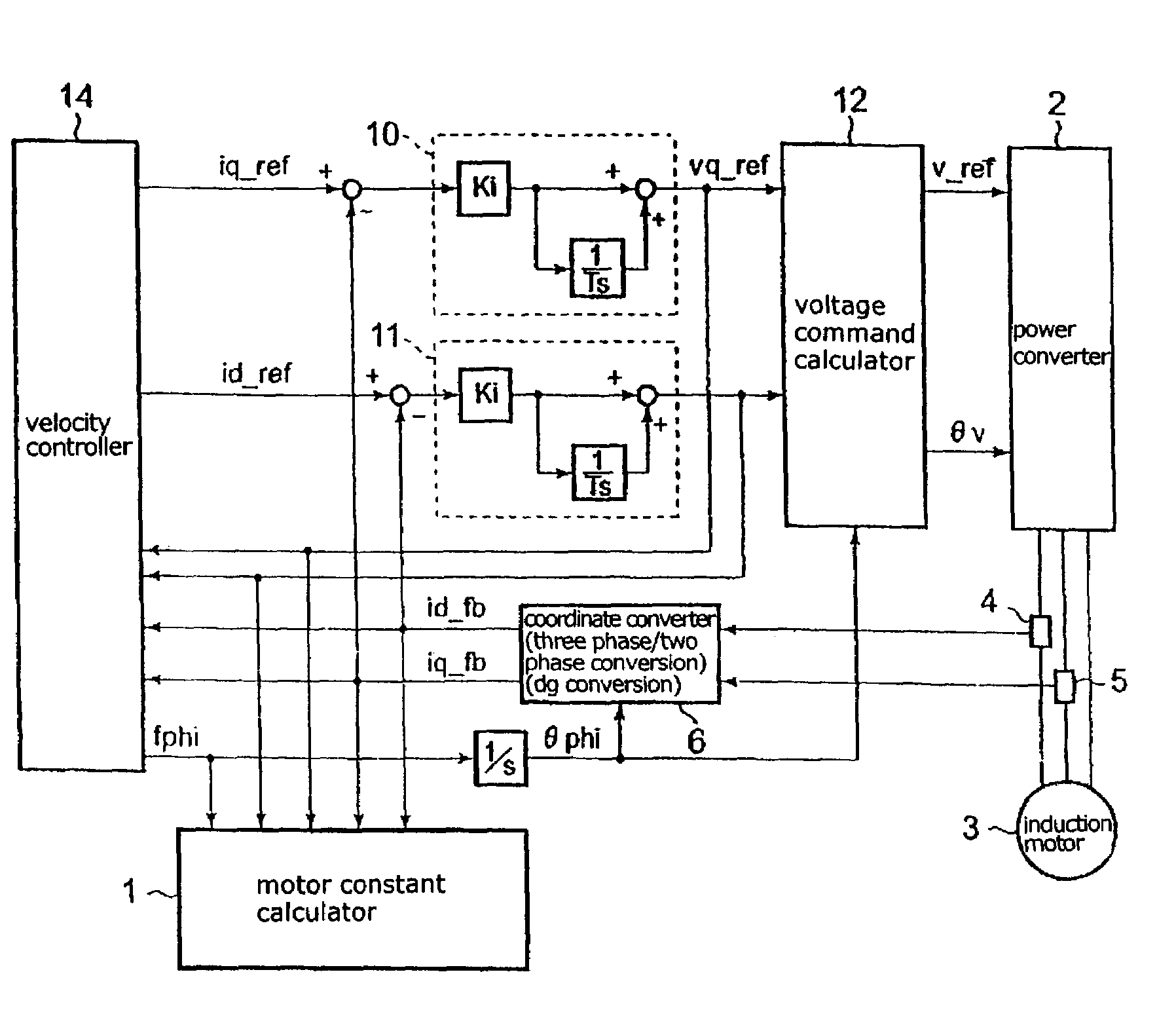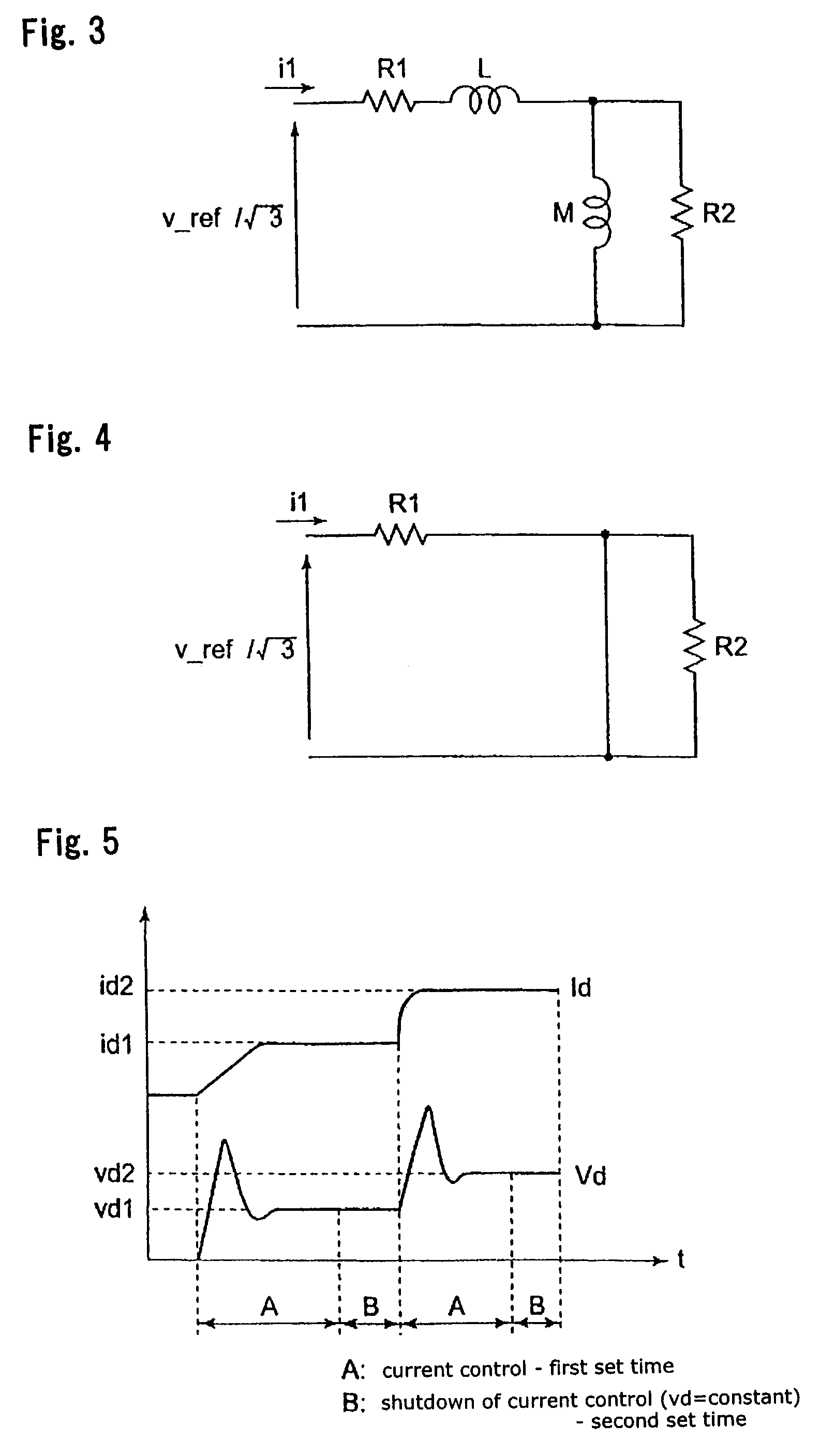Method of measuring motor constant for induction motor
a technology of induction motor and constant, which is applied in the direction of motor/generator/converter stopper, dynamo-electric gear control, motor/generator/converter stopper, etc., can solve the problem of large memory capacity of software, low efficiency, and long software processing time, so as to accurately control the induction motor and accurately tune the primary resistance
- Summary
- Abstract
- Description
- Claims
- Application Information
AI Technical Summary
Benefits of technology
Problems solved by technology
Method used
Image
Examples
first embodiment
[0060]A first embodiment will be described.
[0061]When a DC current is applied to induction motor 3, impedance ωM at mutual inductance M is zero, so that the equivalent circuit in FIG. 3 is changed as illustrated in FIG. 4. Therefore, primary resistance R1 is calculated in accordance with:
R1=(v_ref / √{square root over (3))} / I1
[0062]When setting as a line-to-line resistance, RL-L=2·R1 is handled as the line-to-line resistance. As tuning is started for the primary resistance, iq_ref and id_ref are applied as primary current command values arbitrarily set as a current command. As the current command is given, a voltage command is generated in accordance with the gain of proportional-plus-integral controllers 10, 11, and a three-phase AC voltage is delivered from power converter 2 and applied to motor 3 through which current I1 flows. Current I1 is detected by current detectors 4, 5, subjected to coordinate conversion and current processing, and resulting i_fb is applied to motor constant...
second embodiment
[0063]A second embodiment will be described.
[0064]The present embodiment is a modification of the first embodiment described above, wherein when proportional gain Ki of proportional-plus-integral controllers 10, 11 is set to zero, the q-axis and d-axis voltage commands at that time are substituted into auxiliary voltage command values vq_ref_c and vd_ref_c, respectively, and simultaneously, proportional gain Ki and integral gain (1 / T) of proportional-plus-integral controllers 10, 11, and the outputs of proportional-plus-integral controllers 10, 11 are set to zero, such that a resulting voltage command is applied. The remaining processing is the same as the first embodiment.
third embodiment
[0065]A third embodiment will be described.
[0066]While the current level is measured at two points in the first and second embodiments described above, the measurements are made at three points or more for improving the measurement accuracy in this embodiment. Describing for measurements at three points, when measurements are made at points 1, 2, 3, R1 is calculated in intervals between points 1 and 2, between points 2 and 3, and between points 1 and 3, respectively, or in arbitrary two of these intervals, as is the case in the first and second embodiments, and an average of calculated values is employed as R1 which should be determined. For measurements at four points or more, R1 may be similarly calculated in arbitrary intervals, such that an average of calculated values is used.
PUM
 Login to View More
Login to View More Abstract
Description
Claims
Application Information
 Login to View More
Login to View More - R&D
- Intellectual Property
- Life Sciences
- Materials
- Tech Scout
- Unparalleled Data Quality
- Higher Quality Content
- 60% Fewer Hallucinations
Browse by: Latest US Patents, China's latest patents, Technical Efficacy Thesaurus, Application Domain, Technology Topic, Popular Technical Reports.
© 2025 PatSnap. All rights reserved.Legal|Privacy policy|Modern Slavery Act Transparency Statement|Sitemap|About US| Contact US: help@patsnap.com



